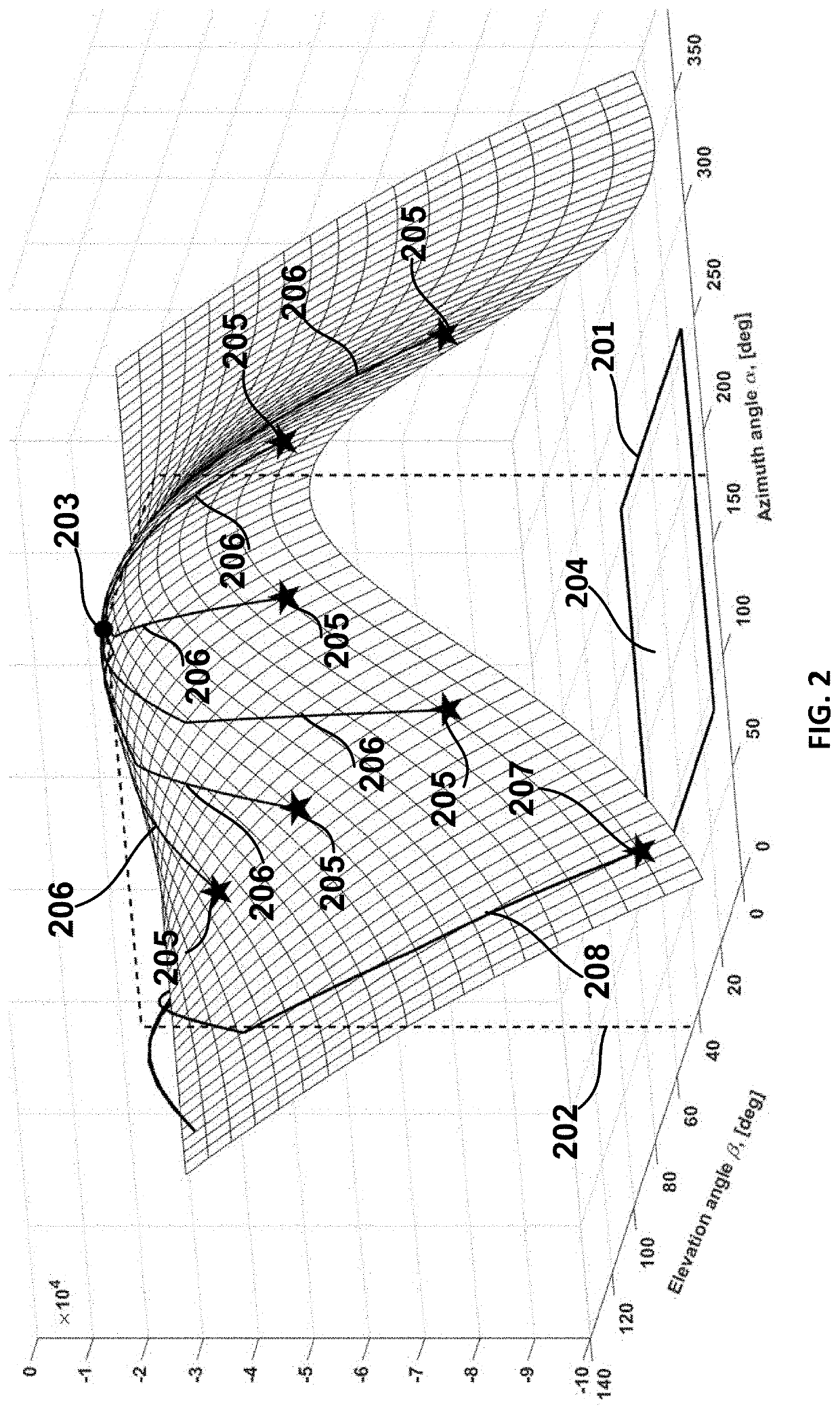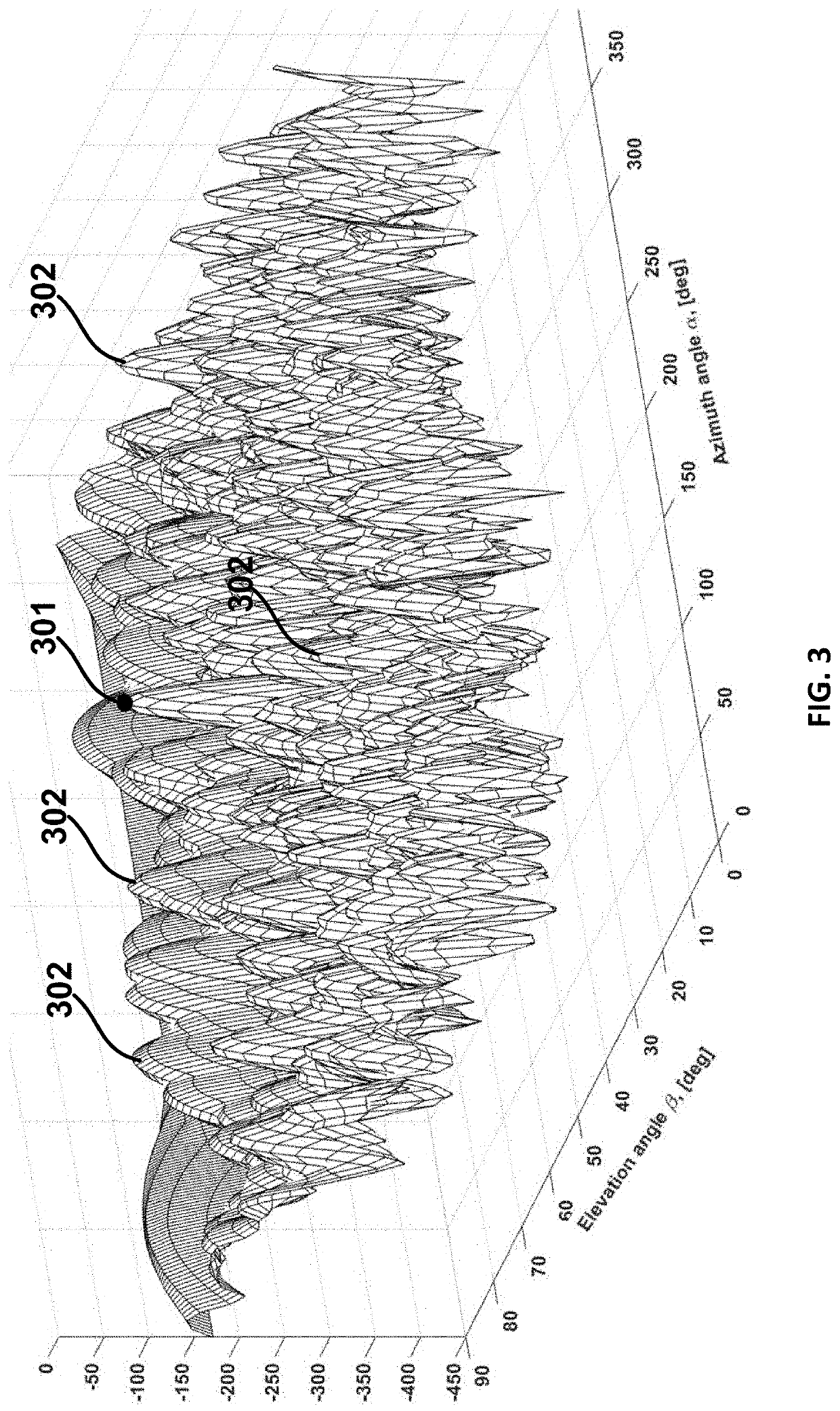[0026]Another method of generating phase differences for NLSM is proposed, different from the known GNSS
interferometry implementations. Here, a measured full carrier
phase difference is presented as a sum of integer carrier cycles and a fractional cycle part. When there is no
random noise, the fractional part of the measured full carrier
phase difference is equal to the fractional part of the true full carrier
phase difference, and the integers of these differences differ in the
integer ambiguity. The proposed method utilized only fractional parts of all available full phase differences as measured values in NLSM, and integers are not considered. The proposed
algorithm does not take into account
integer ambiguity in
processing measurements and hence there is no need to provide actual values of the
ambiguity. This is an
advantage compared to existing methods, because there is no need to constantly control changes in integer
ambiguity and to restart the procedure of resolving integer ambiguities when they have been changed.
[0030]Each pair of antennas in a tri-antenna configuration can generally receive not matching sets of GNSS signals. In this case angular coordinates of two non-collinear base vectors are determined at the same time, independently and according to different sets of GNSS-measurements. As a result of these measurements, two sets of coordinates for two vectors referenced to the same
time moment are obtained. The first set is the coordinates of the base vectors in the vehicle's BF which are highly accurate, do not vary in time, and can be uploaded in the receiver
firmware at the step of
system installation. The second set is the coordinates of the same vectors relative to ENU which have been obtained in GNSS-measurements and distorted by measuring errors. The attitude problem based on noisy coordinates of some non-collinear vectors is well known in navigation as the Wahba problem [1]. For two vectors this problem is a simple determination of attitude base on
two vector measurements obtained from two pairs of GNSS-antennas.
[0038][3] describes a GNSS-based
attitude determination system received signals by four antennas at the same time. To process signals, one of the four antennas is selected as a master antenna, all the other antennas are used as slaves. A movable object, whose attitude is determined, is considered flexible, so
mutual position of antennas can slightly change. The algorithm calculates a change in
mutual position and attitude of the movable objects by co-
processing full phase differences between each pair of the master-slave antennas accumulated over some successive epochs. Integer ambiguities are determined for each calculated set of attitude and
mutual position parameters for all accumulated carrier (phase) differences. However, this algorithm requires four antennas, rather than three. The proposed algorithm does not use integer
ambiguity at the current
attitude determination. And, therefore, there is no need to accumulate measurements over some successive epochs, since it determines attitude based on simultaneous measurements obtained for each epoch. Moreover, it does not require to estimate any change in mutual position of slave antennas with respect to the master antenna.
[0041][6] describes a tri-antenna GNSS-system, integrated with an IMU. The three antennas receive GNSS signals at the same time and carrier single and double differences are constructed on their basis. Integer ambiguities are determined in these differences, and relative coordinates of two slave antennas are further calculated by the moving-base RTK method. Object attitude is then determined from these relative coordinates. If the GNSS signals are unavailable, the vehicle's attitude is extrapolated by the IMU data. When the GNSS
signal resumes, relative coordinates of the slave antennas are calculated based on the extrapolated attitude. Relative calculated coordinates are used for fast determination of integer ambiguities and repeated start-up of the moving-base RTK algorithm. It should be noted that the proposed invention applies a special version of the GNSS
interferometry method without integer ambiguity (the moving base RTK method is used in [6]). Also, the proposed invention uses IMU data for rough initialization of NLSM rather than for calculation of integer ambiguity.
[0042][7] describes an attitude determination system including a dual-antenna GNSS receiver measuring two of three attitude angles of the vehicle's attitude. To obtain a complete orientation, these angles are integrated with IMU data using a
Kalman filter. The distance between antennas must not to be longer than three wavelengths of the received
signal, or 150 mm. Base vector attitude between two antennas is determined by a standard GNSS
interferometry method with integer
ambiguity resolution. Calculation of integer ambiguity at the moment of initial or repetitive initialization of the algorithm is performed by the known procedure called the
transfer alignment which is used when a vehicle moves at variable speed. The proposed invention uses two base vectors (three antennas), whose angular coordinates are obtained by a special version of the GNSS interferometry method without integer ambiguity. The IMU data in the proposed invention are also used for rough initialization of NLSM, rather than for
transfer alignment procedure. It allows quick re-initialization of the proposed algorithm even in case of an unmoving vehicle.
 Login to View More
Login to View More  Login to View More
Login to View More 


